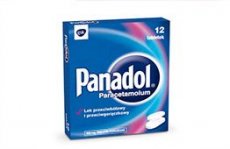Medical expert of the article
New publications
Preparations
Panadol
Last reviewed: 23.04.2024

All iLive content is medically reviewed or fact checked to ensure as much factual accuracy as possible.
We have strict sourcing guidelines and only link to reputable media sites, academic research institutions and, whenever possible, medically peer reviewed studies. Note that the numbers in parentheses ([1], [2], etc.) are clickable links to these studies.
If you feel that any of our content is inaccurate, out-of-date, or otherwise questionable, please select it and press Ctrl + Enter.

Panadol refers to the antipyretic and analgesic agent of the pharmacological group of anilides - non-steroidal anti-inflammatory drugs (NSAIDs) based on paracetamol (aniline derivative). Synonyms: Paracetamol, Acetaminophen, Daleron, Akamol-Teva, Perfalgan, Tylenol, Flutabs, Efferalgan and others.
 [1]
[1]
Indications Panadol
Panadol is intended for relief of headaches (including migraine), toothache, joint and muscle pain. The use of the drug is also indicated for neuralgic, rheumatic and menstrual pain. Panadol relieves symptoms of influenza-like conditions such as fever and headache.
 [2]
[2]
Release form
Product: tablets of 0.5 g.
 [3]
[3]
Pharmacodynamics
The active substance - paracetamol - inhibits the activity of the enzyme cyclooxygenase (COX), which is involved in the synthesis of mediators of inflammation and thermoregulation (prostaglandins).
Decrease in the level of prostaglandins, which ensure the functioning of the limbic-hypothalamic-reticular system of the body, leads to inhibition of neuronal excitation of the center of thermoregulation in the hypothalamus, as well as blocking transmission of painful pulses of the central nervous system and a decrease in protopathic pain sensitivity. The preparation has practically no anti-inflammatory properties.
Pharmacokinetics
After oral administration, paracetamol is absorbed into the digestive tract and enters the systemic circulation. The highest concentration of Panadol in blood plasma is observed in 30-120 minutes after administration. With blood plasma proteins bind not more than 15% of the drug; The active substance of Panadol penetrates the blood-brain barrier.
Biological transformation of the drug occurs in the liver with the formation of metabolites, some of which (almost 17%) are active and deactivation of which occurs under the influence of glutathione liver enzymes. Metabolites are eliminated mainly by the kidneys - with urine; the half-life of the drug from the body varies from 1 to 4 hours.
Dosing and administration
Panadol tablets are taken internally. Single therapeutic dose for adults and children over 12 years is 0.5 g; the drug may be taken three times a day with intervals between doses of 4 hours.
The maximum allowable daily dosage is 4 g, the maximum duration of the course of treatment is 6-7 days.
Use Panadol during pregnancy
The use of Panadol during pregnancy can only be as prescribed by the doctor, when the expected benefit to the pregnant woman is higher than the possible threat to the fetus.
Contraindications
Side effects Panadol
In most cases, the short-term use of Panadol in therapeutic doses of side effects does not occur. However, with prolonged use, the drug causes nausea, vomiting, pain in the stomach, hyperactivity of liver enzymes, skin flushing and urticaria, negative changes in blood composition (anemia, thrombocytopenia, sugar and uric acid content).
Metabolites of paracetamol can also cause iron oxidation in hemoglobin, which leads to the formation of methhemoglobin and blockage of oxygen transfer by blood, known as methemoglobinemia and manifested as dyspnea, cyanosis and heart pain.
 [15]
[15]
Overdose
Using Panadol in doses exceeding therapeutic, the following side effects may develop:
- loss of appetite, nausea and vomiting;
- pain in the stomach;
- heart rhythm disorder;
- change in the pH of the organism towards increasing acidity;
- violation of carbohydrate metabolism;
- lowering of blood sugar level;
- pancreatitis;
- toxic liver damage;
- renal failure with tubular necrosis;
- bleeding;
- coma.
The treatment for the overdose of Panadol is Methionine (ingestion) and Acetylcysteine (intravenously).
Interactions with other drugs
Panadol can not be used in combination with other drugs containing paracetamol.
The combination of taking Panadol with anticoagulants group of coumarins, the effect of the latter is intensified. The simultaneous use of Panadol reduces the effect of diuretics.
The absorption of Panadol is increased when combined with the use of Domperidone and Metoclopramide; its antipyretic effect is reduced in the case of simultaneous reception of barbiturates.
Shelf life
Shelf life of the drug is 5 years.
Attention!
To simplify the perception of information, this instruction for use of the drug "Panadol" translated and presented in a special form on the basis of the official instructions for medical use of the drug. Before use read the annotation that came directly to medicines.
Description provided for informational purposes and is not a guide to self-healing. The need for this drug, the purpose of the treatment regimen, methods and dose of the drug is determined solely by the attending physician. Self-medication is dangerous for your health.

